- Red panda habitat and adaptations to the environment.
- The diet and unique feeding habits of red pandas.
- The conservation status and efforts to preserve red panda populations.
- The importance of red pandas in biodiversity and ecosystem health.
- Human interactions with red pandas and zoo management practices.
Red pandas, scientifically known as Ailurus fulgens, are not just captivating creatures but a vital part of the biodiversity in the cool, temperate forests of southeast Asia. These forests stretch across the mountainous regions where Bhutan, China, India, Myanmar, and Nepal lie. Adapted to thrive in altitudes ranging from 1,800 to 4,000 meters, red pandas have several fascinating adaptations, allowing them to live comfortably in these rugged terrains.
One of the most striking features of the red panda is its thick, bushy fur which covers even the soles of its feet. This adaptation is essential for maintaining body heat amid the cold climate and provides a better grip as they climb frosty tree branches. The fur pattern also serves a practical purpose. The reddish-brown color helps these arboreal animals blend seamlessly into the canopies of the evergreen and deciduous forests. Their ability to mix into the background is crucial for evading predators.
When discussing the feeding habits of red pandas, it is important to note their classification as carnivores, despite a diet that predominantly consists of bamboo—a rather unexpected food choice. Bamboo constitutes about 85-95% of their diet, supplemented with fruits, berries, mushrooms, roots, and grubs. Their strong, curved claws and a false thumb—a modified wrist bone—aid them in grasping the bamboo stalks. This dietary preference stems from a digestive system that can handle fibrous plant material. However, they lack the specialized stomachs seen in herbivores to break down cellulose efficiently, necessitating high intake levels to meet nutritional needs.
Conservation of red pandas is crucial, as these animals are listed as endangered on the IUCN Red List. The population is estimated to be less than 10,000 mature individuals in the wild, with a continuing decline due to habitat loss, poaching, and inbreeding depression. Deforestation for agriculture and illegal logging are primary drivers of habitat destruction. Conservation strategies focus on habitat preservation through the establishment of protected areas, strengthening anti-poaching laws, and supporting community-based conservation programs. Captive breeding and research in accredited zoos also play a significant role in raising awareness and ensuring species survival.
Red pandas play a critical role in maintaining the health of their ecosystem. As seed dispersers and part of the food web, they help sustain forest diversity. Their presence within the ecosystem serves as an indicator of environmental health, providing insight into the overall state of their habitat. Biodiversity is richer and more stable in balanced ecosystems where species like the red panda thrive.
Human interactions with red pandas—whether through ecotourism or in zoos—are powerful tools for education and conservation. In zoos, particular attention is given to creating enclosures that mimic their natural habitats, providing environmental enrichments such as climbing structures and opportunities for foraging to stimulate natural behaviors. Zoo management practices aim to minimize stress and foster healthy breeding climates. Public education initiatives encourage an understanding of their ecological importance and the challenges they face. These interactions also compel individuals and communities to contribute to conservation efforts both locally and globally.
Red pandas, despite their adorable appearance, represent more than just an enchanting species. They are integral to ecological balance and possess a profound connection to the temperate forest ecosystems. Continued study and conservation of the red panda are paramount to the health and sustainability of this region, urging us all to take greater action in preserving these charming creatures for future generations.
*****
Source Description
Red panda or cinnamon roll dusted with powdered sugar? You decide.
Native to the cool, temperate forests of southeast Asia, red pandas have thick fur – even on their paws! 🐾 This helps them stay warm and grip icy branches as they navigate their snowy mountain homes. Talk about the ultimate winter gear!


